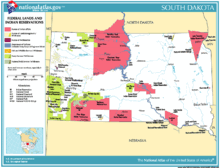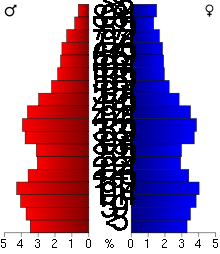- Demographics of South Dakota
-
Contents
Population
According to the U.S. Census Bureau, as of 2005, South Dakota has an estimated population of 775,933, which is an increase of 5,312, or 0.7%, from the prior year and an increase of 21,093, or 2.8%, since the year 2000. This includes a natural increase since the last census of 19,199 people (that is 56,247 births minus 37,048 deaths) and an increase due to net migration of 3,222 people into the state. Immigration from outside the United States resulted in a net increase of 3,957 people, and migration within the country produced a net loss of 735 people. 6.8% of South Dakota's population were reported as under 5, 26.8% under 18, and 14.3% were 65 or older. Females made up approximately 50.4% of the population. The center of population of South Dakota is located in Buffalo County, in the unincorporated county seat of Gannvalley.[1]
Race and ethnicity
 South Dakota has a number of large Indian reservations (shown in pink).
South Dakota has a number of large Indian reservations (shown in pink).
In 2005, the Census Bureau estimated that 88.5% of South Dakotans were White, 8.8% were American Indian or Alaskan Native, 2.1 were Hispanic (of any race), 0.8% were Black, 0.7% were Asian, while 2.1% belonged to more than one race.[2] The five largest ancestry groups in South Dakota are: German (40.7%), Norwegian (15.3%), Irish (10.4%), Native American (8.3%), and English (7.1%).[3] German-Americans are the largest ancestry group in most parts of the state, especially in the east, although there are also large Scandinavian populations in some counties. South Dakota has the nation's largest population of Hutterites,[4] a communal Anabaptist group who emigrated from Europe in 1874.
American Indians, largely Lakota, Dakota, and Nakota (Sioux) are predominant in several counties. South Dakota has the third highest proportion of Native Americans of any state, behind Alaska and New Mexico.[5] Five of the state's counties lie entirely within Indian reservations.[6] Living standards on many reservations is often very low when compared with the national average. The unemployment rate in Fort Thompson, on the Crow Creek Indian Reservation, is 70%, and 21% of households there lack plumbing or basic kitchen appliances.[7] A 1995 study by the U.S. Census Bureau found that 58% of homes on the Pine Ridge Indian Reservation did not have a telephone.[8]
As of the 2000 census, 1.90% of the population aged 5 or older speak German at home, while 1.51% speak Dakota, and 1.43% Spanish.[9]
Demographics of South Dakota (csv) By race White Black AIAN* Asian NHPI* 2000 (total population) 90.36% 0.90% 9.06% 0.80% 0.07% 2000 (Hispanic only) 1.21% 0.04% 0.24% 0.02% 0.01% 2005 (total population) 89.64% 1.17% 9.43% 0.92% 0.06% 2005 (Hispanic only) 1.83% 0.07% 0.23% 0.02% 0.00% Growth 2000–05 (total population) 1.98% 33.36% 7.02% 17.99% -9.87% Growth 2000–05 (non-Hispanic only) 1.25% 31.10% 7.20% 18.58% -5.69% Growth 2000–05 (Hispanic only) 55.60% 78.64% 0.17% -6.21% -41.54% * AIAN is American Indian or Alaskan Native; NHPI is Native Hawaiian or Pacific Islander Growth and rural flight
Historical populations Census Pop. %± 1860 4,837 — 1870 11,776 143.5% 1880 98,268 734.5% 1890 348,600 254.7% 1900 401,570 15.2% 1910 583,888 45.4% 1920 636,547 9.0% 1930 692,849 8.8% 1940 642,961 −7.2% 1950 652,740 1.5% 1960 680,514 4.3% 1970 665,507 −2.2% 1980 690,768 3.8% 1990 696,004 0.8% 2000 754,844 8.5% Est. 2008[10] 804,194 6.5% South Dakota, in common with five other Midwest states (Nebraska, Kansas, Oklahoma, North Dakota, and Iowa), is experiencing a trend of falling populations in rural counties, despite an overall increase in population for all of these states except North Dakota. 89% of the total number of cities in these six states have fewer than 3,000 people; hundreds have fewer than 1000. Between 1996 and 2004, almost half a million people, nearly half with college degrees, left the six states. "Rural flight" as it is called has led to offers of free land and tax breaks as enticements to newcomers.
The effect of rural flight has not been spread evenly through South Dakota, however. Although most rural counties and small towns have lost population, the Sioux Falls area and the Black Hills have gained population. In fact, Lincoln County, near Sioux Falls, is the ninth-fastest growing county (by percentage) in the United States.[11] The growth in these areas has compensated for losses in the rest of the state, and South Dakota's total population continues to increase steadily, albeit at a slower rate than the national average.[2]
Religion
According to a 2001 survey, 86% of South Dakotans described themselves as being members of a Christian denomination, while 8% said that they were not religious and 3% claimed faith in a non-Christian religion. The largest Christian denomination was Lutheran (27%), followed closely by Roman Catholic at 25%. Other Christian denominations mentioned included Methodist (13%), Baptist (4%), Presbyterian (4%), Pentecostal (2%), Congregational (2%), Episcopal/Anglican (1%), and Seventh-day Adventist (1%). 7% responded either as a non-denominational Christian or a Protestant, while 2% refused to answer.[12]
References
- ^ "Population and Population Centers by State - 2000". United States Census Bureau. http://www.census.gov/geo/www/cenpop/statecenters.txt. Retrieved 2007-08-18.
- ^ a b "State and County Quickfacts (South Dakota)". United States Census Bureau. http://quickfacts.census.gov/qfd/states/46000.html. Retrieved 2007-04-10.
- ^ "Quick Tables". United States Census Bureau. http://factfinder.census.gov/servlet/QTTable?_bm=n&_lang=en&qr_name=DEC_2000_SF3_U_DP2&ds_name=DEC_2000_SF3_U&geo_id=04000US46. Retrieved 2008-08-29.
- ^ "Color them plain but successful". The Federal Reserve Bank of Minneapolis. http://www.minneapolisfed.org/publications_papers/pub_display.cfm?id=1409. Retrieved 2008-12-14.
- ^ "States Ranked by American Indian and Alaska Native Population, July 1, 1999". United States Census Bureau. http://www.census.gov/population/estimates/state/rank/aiea.txt. Retrieved 2008-12-14.
- ^ "Press Releases - Uniquely South Dakota". South Dakota Department of Tourism. http://www.travelsd.com/Newsroom/pressreleases/uniquelysd.asp?id=356. Retrieved 2008-08-22.
- ^ Hetland, Cara. South Dakota has nation's poorest county. [1] Minnesota Public Radio. October 1, 2002. (accessed December 19, 2008)
- ^ "Transportation and Tourism Development at the Pine Ridge Indian Reservation". Federal Highway Administration. http://www.fhwa.dot.gov/planning/econDev/pineridge.htm. Retrieved 2008-12-19.
- ^ "Most Spoken Languages in South Dakota". www.mla.org. http://www.mla.org/map_data_results&state_id=46&mode=state_tops. Retrieved 2007-08-18.
- ^ "Population Finder - South Dakota". United States Census Bureau. http://factfinder.census.gov/servlet/SAFFPopulation?_event=Search&_name=&_state=04000US46&_county=&_cityTown=&_zip=&_sse=on&_lang=en&pctxt=fph. Retrieved 2009-07-02.
- ^ "100 Fastest Growing Counties". United States Census Bureau. http://www.census.gov/popest/counties/CO-EST2004-09.html. Retrieved 2007-04-10.
- ^ "American Religious Identification Survey". Exhibit 15. The Graduate Center, City University of New York. http://www.gc.cuny.edu/faculty/research_briefs/aris/key_findings.htm. Retrieved 2007-04-06.
Demographics of the United States by state Demographics by state Alabama • Alaska • Arizona • Arkansas • California • Colorado • Connecticut • Delaware • Florida • Georgia • Hawaii • Idaho • Illinois • Indiana • Iowa • Kansas • Kentucky • Louisiana • Maine • Maryland • Massachusetts • Michigan • Minnesota • Mississippi • Missouri • Montana • Nebraska • Nevada • New Hampshire • New Jersey • New Mexico • New York • North Carolina • North Dakota • Ohio • Oklahoma • Oregon • Pennsylvania • Rhode Island • South Carolina • South Dakota • Tennessee • Texas • Utah • Vermont • Virginia • Washington • West Virginia • Wisconsin • WyomingFederal district Demographics by city Categories:
Wikimedia Foundation. 2010.


